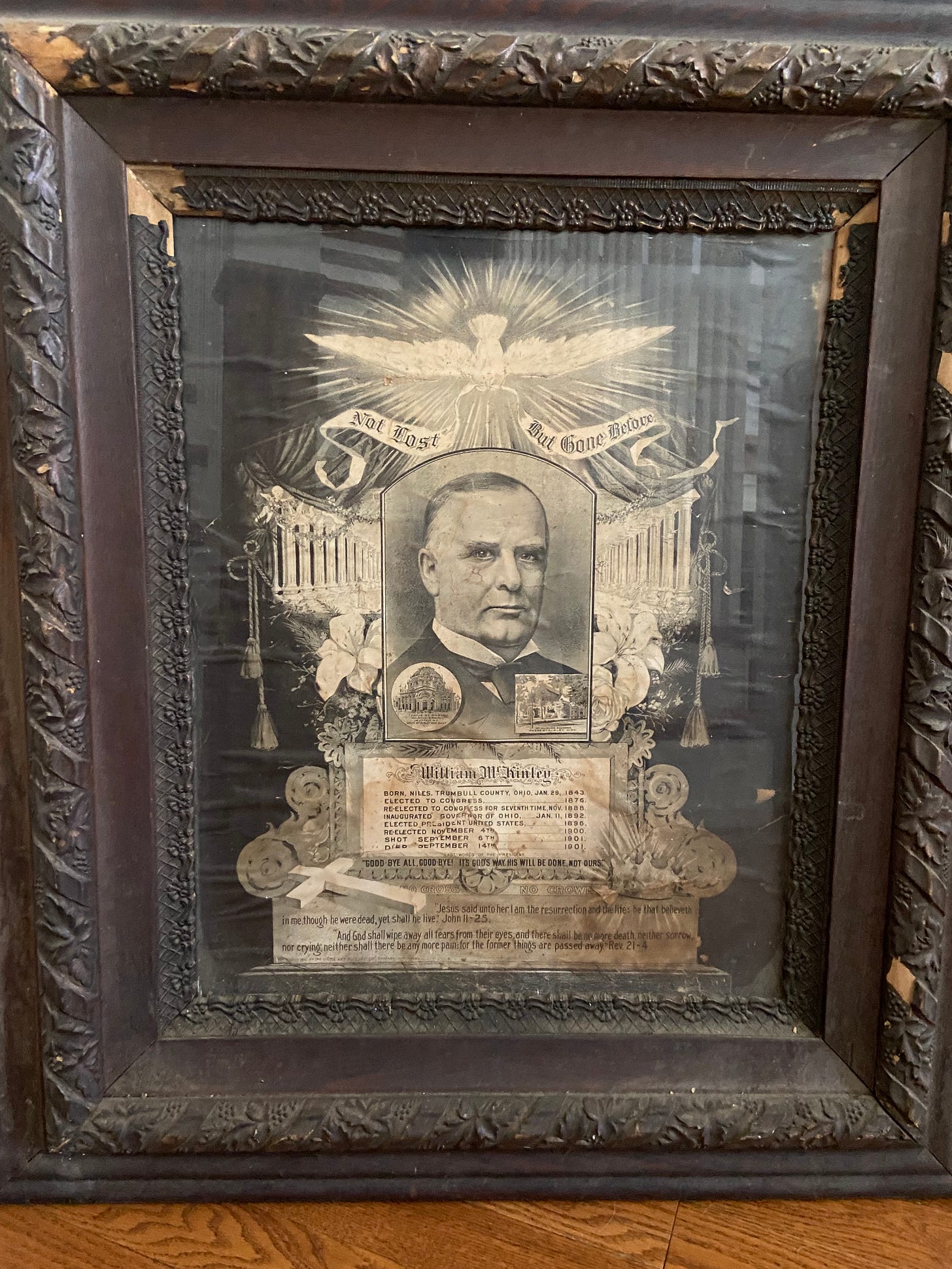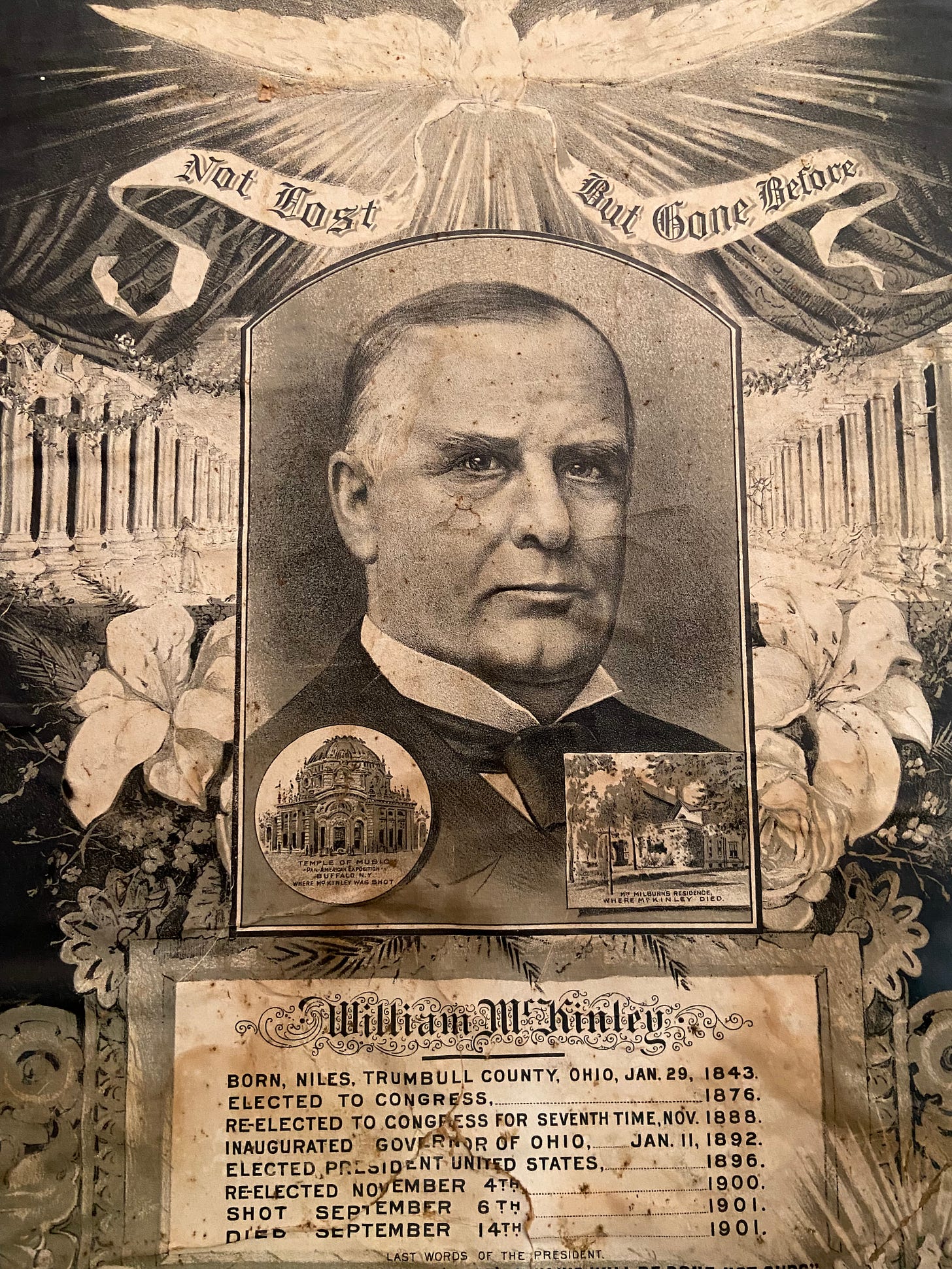Hello, again. It’s been a while. Thank you for your patience.
As I mentioned some weeks ago, I’ve been on a quest for dead presidents. As with every good quest, mine was long and fruitless, but after enduring much hardship and toil, faith was rewarded.
Which is to say, on the drive from Ontario to New Brunswick, I went through every bloody antique store in Maine — and Maine has a lot of antique stores — without a glimpse of a dead president. The closest I came was the store owner who squinted, pondered a while, and sighed, “I had a Grover Cleveland a while back.” Agony. The torment of Sir Percival. I soldiered on, got to New Brunswick, and consoled myself by buying a tin with a dead monarch. Not that I count British monarchs below American presidents, mind you — I’m one of those very old-fashioned Canadians who thinks George Washington deserved to be hanged — but dead monarchs are rather, dare I say it, common in Canada.
The drive back had to be done in one day, which meant a short stretch through the interior of Maine, then Quebec and final failure. But I wan’t defeated yet. I still had Skowhegan.
It’s an interesting town. Like much of rural Maine, it’s a little down-at-the-heels now, but in the 19th century, river-powered mills generated the money that built impressive Victorian homes and a gorgeous main street. With these good bones, Skowhegan has attracted a touch of hipsterdom. There are two craft breweries and a regional craft brewery festival (it’s today, if you want to jump in the car and drive fast). There is a ridiculously excellent bakery — called “The Bankery” as it’s in an old bank— the equal or superior of any I’ve encountered in a major city. But most importantly, Skowhegan has, to my taste, the best antique store in Maine. The last time I was in Hilltop Antiques, I found my treasured 1933 portrait of FDR. Skowhegan was my last, best hope.
I walked in and almost immediately saw a framed 1935 collage portrait of FDR touting his inspirational achievements using language quite different from the usual descriptions of the New Deal. It was a nifty illustration that, only two years in, the “New Deal” was an evolving melange of experiments, policies, and concepts, not the straightforward program we read about in textbooks. This portrait was not the Holy Grail, as I already had an FDR. But I tucked it under my arm, and was happy that my quest would end in relative success.
Hilltop Antiques is a big, sprawling store. To save time, I had sent my minions out in search of dead presidents. One returned, smiling. In his hands was … the Holy Grail.
A portrait of the 25th president, William McKinley.
It is mostly black. A white banner reads, “not lost, but gone before.” A white dove grasps the banner in its beak, its wing spread wide and white, like those of angels. I instantly realized the portrait honoured the recently deceased President William McKinley — shot to death by an anarchist, Leon Czolgosz, in 1901. McKinley’s untimely demise elevated his unlikely vice president, Theodore Roosevelt, to the presidency, a post the volatile progressive would probably never have obtained the usual route.
This portrait was the product of one of the seminal events of the beginning of the 20th century. I’ll show you a picture below. For now, savour the glory of the moment….
OK, I get that some people wouldn’t be quite as thrilled as I was. The frame is filthy and chipped. The portrait is water-stained and wrinkled, probably because it sat in a shed, in backwoods Maine, for most of the past hundred years. And it cost twenty bucks. By Maine antique store standards, that’s a please-get-this-crap-out-of-here price. So, yes, I am aware that my love for this thing is unusual.
But aside from its historical significance, there’s something else that makes me love it (and others like it). To see it, let me show you the back first.
That backing is plain old corrugated cardboard cut crudely from a box (as the “this side up” makes clear). And yes, the portrait was hung on a cheap chunk of old rope. Now think about what that says. The person who assembled this used whatever materials were at hand to frame and hang a memorial to a murdered president. And the materials at hand were dirt cheap. So this portrait was probably — and yes, I am imaginatively filling in large blanks — framed and hung by a person of very modest means but intense feeling: This was a poor person’s expression of a deeply felt political conviction. And I find that fascinating, as a perspective radically removed removed from mine.
In that sense, I’ve found many other objects like it. My favourite was a portrait of Queen Elizabeth on her 1953 coronation, which I bought in a little town in the Ottawa Valley. After disassembling it, I found the portrait itself was simply newsprint. It came from a long forgotten edition of the Toronto Star, a daily newspaper. The backing was made of old boards shaved down at their edges to fit into the frame. And the frame! At first it looked like four slabs of wood carefully gouged and shaved, and stained a deep brown, to look rustic. The sort of thing sold as “primitive art” to tourists. In fact, the frame was made of chunks of old boards that had been hand-split by an axe, crudely stained, and nailed together, and it surely was not made to be sold as “primitive art” to tourists because it was valueless decades ago and close to valueless when I bought it. It is a safe guess, therefore, that this portrait of Her Majesty, Elizabeth II, by the Grace of God, of the United Kingdom of Great Britain and Northern Ireland and of her other realms and territories Queen, Head of the Commonwealth, Defender of the Faith, etc., was built, assembled, and placed on a wall by a dirt-poor Ottawa Valley farmer. It was a humble man’s earnest expression of his political faith. That’s a different perspective. An interesting perspective.
Incidentally, you may be wondering … “cardboard? Did they have corrugated cardboard in 1901?” I wondered that, anyway. So I looked it up. It seems corrugated cardboard was invented in England in the 1870s and corrugated cardboard boxes were being mass-produced in the United States by the late 1890s. I was also doubtful about the age of the phrase “this side up” but Google N-grams and a search of newspapers assures me it was commonplace in the 19th century.
Anyway, here is the portrait in all its glory.
And a closeup:
I am sure you share my bedazzlement. But Hilltop Antiques wasn’t done. When I chatted with the owner — whose name I forgot to ask, apologies, so over-caffeinated and over-wrought was I — he told me, “I have a whole graveyard of dead presidents.” (You have to imagine that in a thick Maine accent.) He took me to a stack of collectibles produced in the 1920s, each a framed medal with the profile of one of the presidents. Some had already been sold. But there were lots of the big names, including Lincoln. But I’ve been reading about the 1920s for most of this year, and I prefer political objects that commemorate the era in which they were made, so I bought the three Republican presidents who presided over the 1920s (and about whom I’ll write more soon): Harding, Coolidge, and Hoover.
Feeling like Stanley after finding Livingstone, I squeezed my treasures into a car overstuffed with minions and their baggage and returned home.
And that, class, is how I spent my summer vacation. Thanks for listening.









Fascinating timing, with the death of the queen today. A lovely post, thanks for sharing.
Good on you Dan. I could feel your enthusiasm and excitement streaming thru the electrons!!